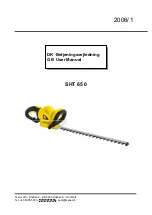
㩷
15
– Firmly hold the clutch case by your left hand, as illustrated.
– Slowly pull the starter grip until resistance is felt and continue with a smart
pull.
– Do not pull out the starter rope to its full extent and do not allow the starter
handle to be retracted without control, but ensure that it is retracted slowly.
– Repeat the starting operation until initial ignitions are heard.
– When the engine starts, please open the throttle lever a little. The choke
button being automatic, it returns to original position “ ”.
– Run the engine for approximately one minute at a moderate speed before applying full throttle.
Note:
−
If the starter handle is pulled repeatedly when the choke button remains at “ ” position, the engine will not start easily due to
excessive fuel intake.
−
In case of excessive fuel intake, remove the spark plug and pull the starter handle slowly to remove excess fuel. Also, dry the
electrode section of the spark plug.
Caution during operation:
If the throttle lever is opened fully in a no-load operation, the engine rotation is increased to 10,000rpm or more. Never operate the engine at a
higher speed than required and at an approximate speed of 6,000 - 8,000rpm.
Starting the warm engine
– As described above, except without moving the choke button.
Stopping
– Release the throttle lever (2) fully, and when the engine rpm has lowered,
push the I-O switch (1) to “O” position the engine will now stop.
– Be aware that the cutting head may not stop immediately and allow it to slow
down fully.
IDLE ADJUSTMENT
The cutter blade or the nylon cutting head should not run when the control lever is fully released. If necessary, adjust the idle rpm using the
idle adjusting screw.
㩷
Checking the Idling speed
– Idle speed should be set to 3,000rpm.
If necessary correct it by means of the idle screw (the blade or the nylon
cutting head must not turn when the engine is on idle).
Screwing in the screw (1) will cause an increase in the engine speed,
whereas backing off the screw will reduce the engine speed.
㩷
㩷
㩷
Slow
High
















































